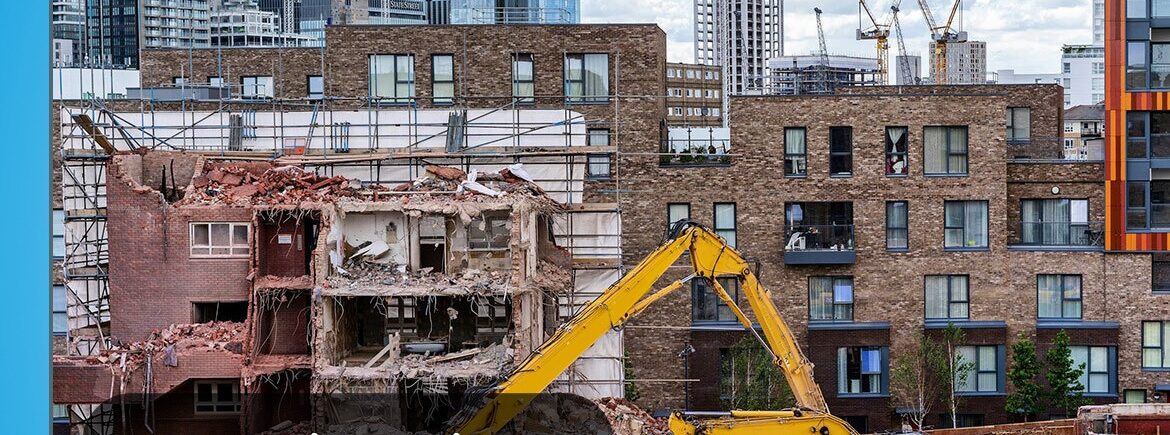With limited space and a growing demand for modern facilities, construction business in London face the unique challenge of optimizing every available area.
Demolition and refurbishment play a central role in this process, enabling builders to replace outdated structures while transforming others to meet current standards. By balancing these two approaches, construction companies are driving the development of sustainable, efficient spaces that meet London’s evolving needs.
In this blog, we’ll explore the importance of demolition and refurbishment, the process behind them, and much more.

The Importance Of Demolition And Refurbishment
1) Why Demolition?
Demolition removes outdated structures, opening prime urban spaces for new projects. In London, where every square meter counts, demolition allows developers to maximise land use. B-Line, among the leading construction services London firms, specializes in controlled demolition, ensuring minimal disruption to the environment and neighboring buildings.
Innovative demolition tools and methods, such as diamond cutting ensure safety and precision. This allows companies to operate efficiently in densely populated urban settings without compromising safety.
2) Why Refurbishment?
Refurbishment gives a new lease of life to old buildings, preserving architectural value while aligning with contemporary needs. Instead of demolition, many Construction Business projects in London focus on sustainable refurbishment, reducing waste, and retaining heritage. Construction Business projects gain significant value by restoring buildings and reducing the carbon footprint associated with new construction.
Demolition: The Process
1. Site Survey and Structural Assessment
In the construction business, a thorough site survey and structural assessment are essential before any demolition work begins. This initial step enables contractors to identify structural vulnerabilities, assess the surrounding environment, and anticipate potential hazards. A comprehensive survey also aids in selecting the most effective demolition method, prioritizing both safety and operational efficiency.
2. Obtaining Permits
For any construction to be done in London, strict regulations apply to demolition projects. Contractors must secure permits from local authorities, which outline safety standards and environmental regulations. This ensures that the demolition is carried out in compliance with all relevant laws.
3. Safety Measures and Environmental Considerations
Safety is the top priority during demolition. Installing scaffolding, securing nearby structures, and ensuring that asbestos and other hazardous materials are safely removed are essential steps. Additionally, contractors now prioritize recycling materials from demolition, supporting London’s sustainability goals.
4. Demolition Execution
Different techniques are used by building contractors london based on the site. Controlled implosions may be used for large structures, while smaller buildings may be deconstructed piece by piece. This flexibility allows for minimal disruption to surrounding areas and safer working conditions.
What Does The Refurbishment Process Involve?
1. Structural Assessment
Much like demolition, refurbishment begins with a structural assessment. This helps contractors understand which parts of the building can be preserved and what needs to be strengthened. It’s particularly important in historical buildings, where retaining the facade or other key elements is essential.
2. Energy Efficiency Upgrades
In modern refurbishment projects, improving a building’s energy efficiency is often a priority. Retrofitting windows, upgrading insulation, and installing modern HVAC systems all contribute to lowering the building’s carbon footprint while improving its usability.
3. Modern Amenities and Safety Compliance
Incorporating modern amenities while ensuring the building complies with safety regulations is a key part of refurbishment and construction business. Fireproofing, installing energy-efficient systems, and ensuring disability access all contribute to making older buildings fit for modern use.
Demolition vs. Refurbishment: A Balanced Approach
In the construction business, a well-measured blend of demolition and refurbishment can help meet both modernization demands and sustainability goals. Demolition clears the way for innovative, large-scale projects, while refurbishment enhances and preserves existing structures, adding value to our built environment. By strategically combining these approaches, construction companies can create spaces that balance functionality, aesthetics, and environmental impact.
B-Line’s Expertise in London’s Construction Business
If you’re in London looking for a “building demolition contractors near me” you will surely find B Line on top of the list. As a trusted name in London, B-Line excels in controlled demolition and refurbishment projects.
Our commitment to precision and safety ensures each project runs smoothly, with minimal disruption to surrounding communities. Using advanced equipment and experienced teams, we navigate complex demolition tasks efficiently.
Conclusion
Demolition and refurbishment are foundational aspects of the construction business that enable cities like London to evolve while preserving their unique cultural identity
B-Line plays a key role by providing expert demolition and refurbishment services that align with London’s safety and environmental regulations. With a commitment to quality and innovation, we ensure that every project adds value to the city’s growth.
Need our expertise? Visit our website now!


